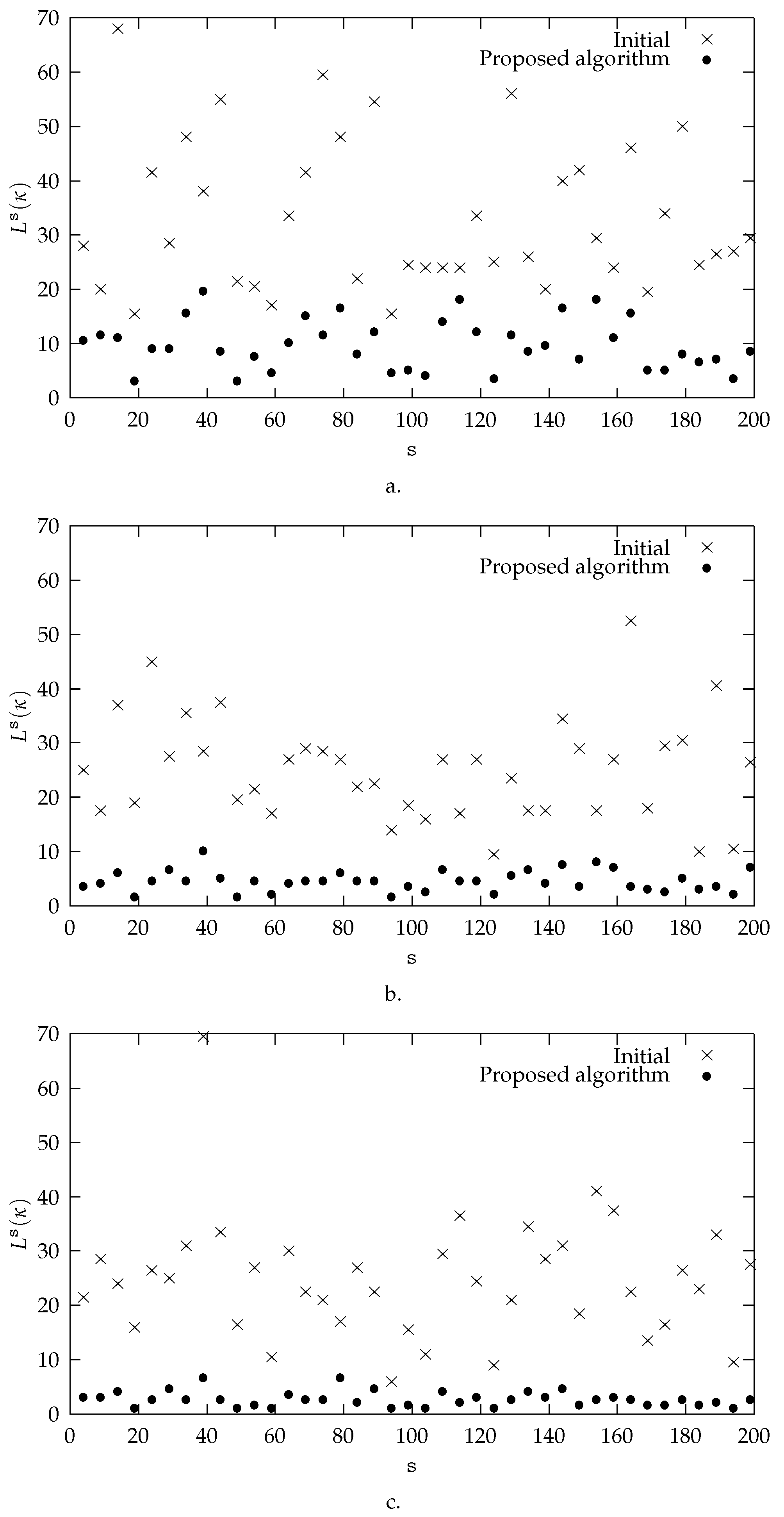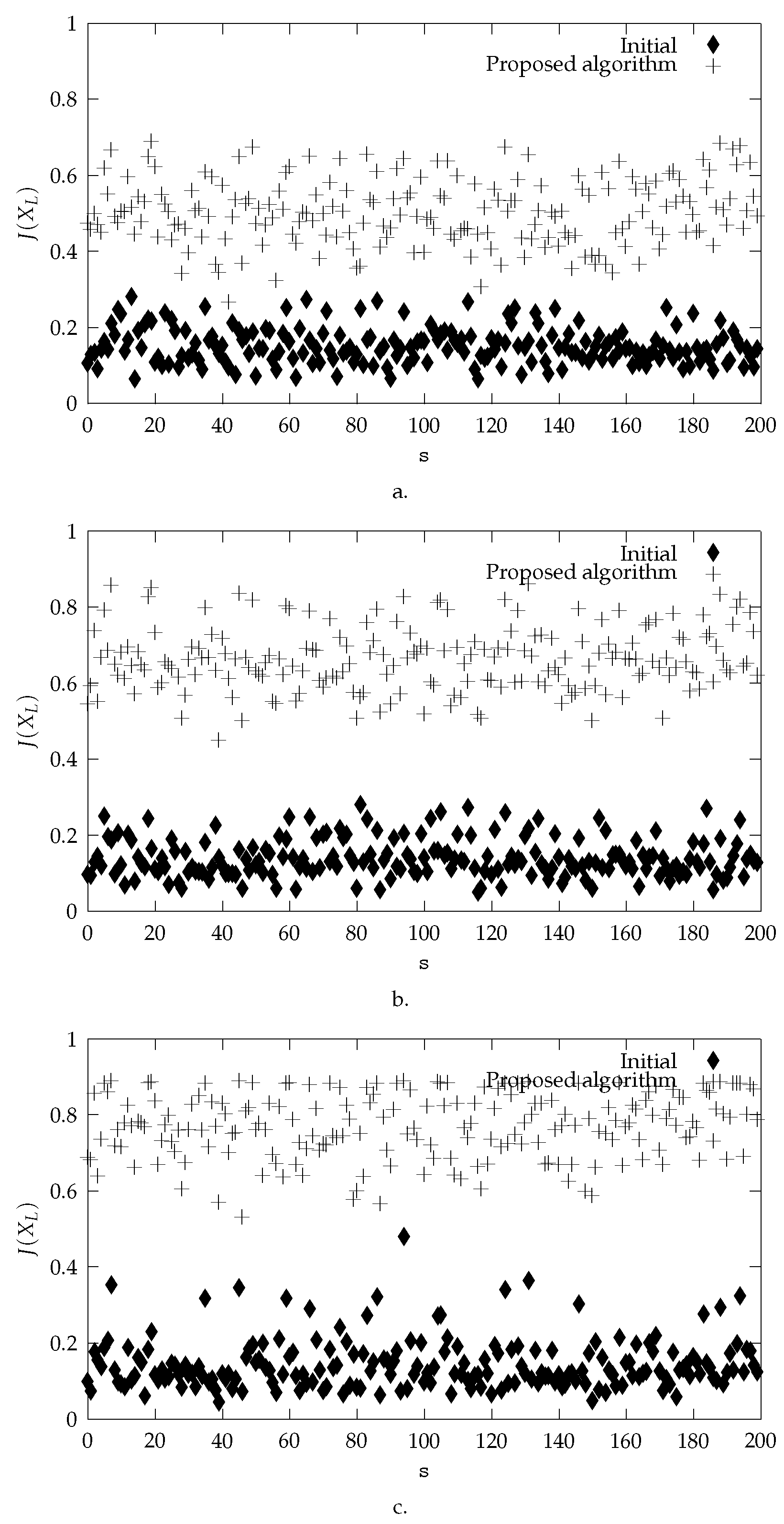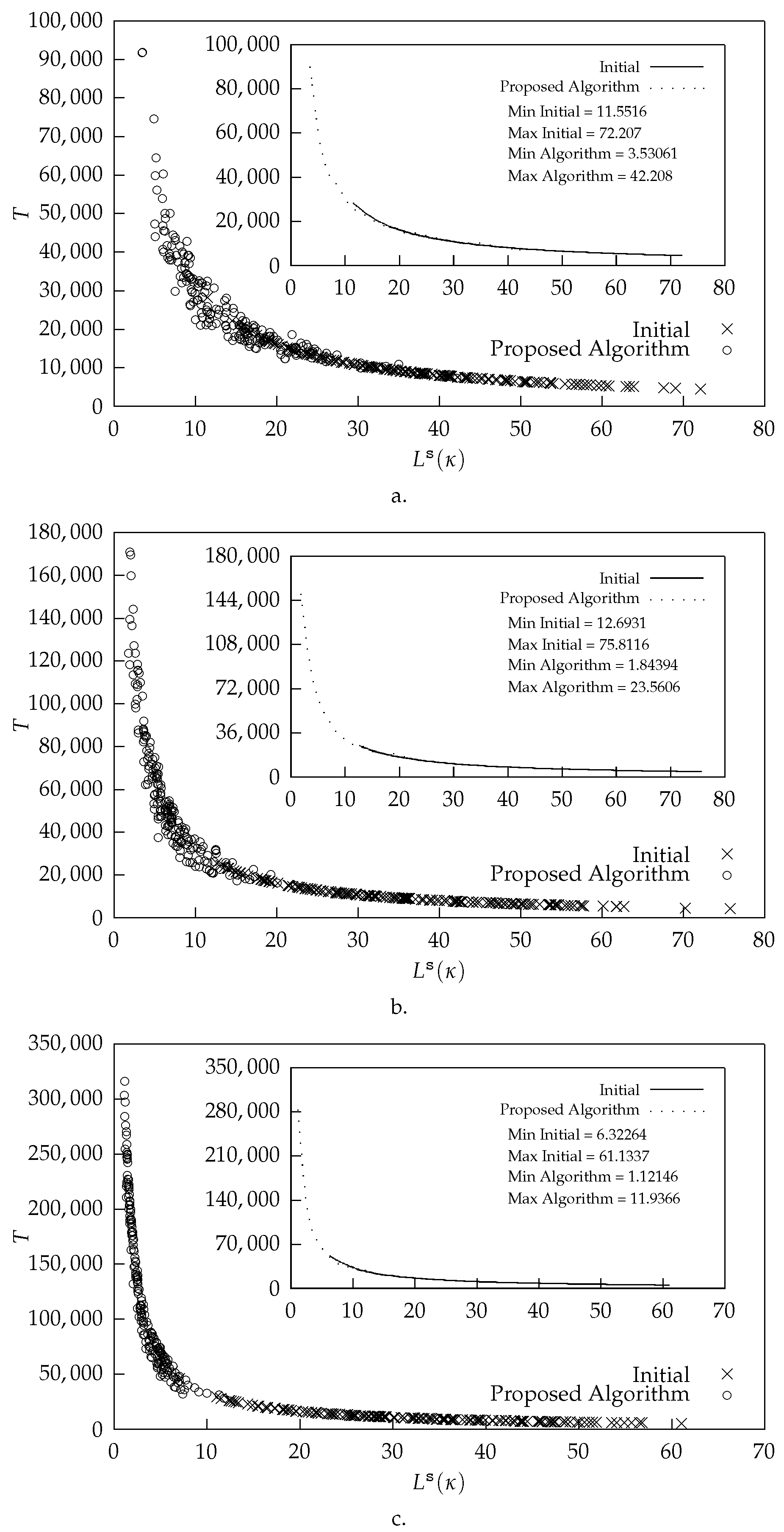A Traffic-Load-Based Algorithm for Wireless Sensor Networks’ Lifetime Extension
Abstract
:1. Introduction
2. Related Work
3. System Definition
3.1. Topology Model
3.2. The Sink Node
3.3. Routing Model
3.4. Traffic Load Model
3.5. Energy Model
4. The Proposed Algorithm
4.1. The Most Energy-Consuming Node
4.2. The Proposed Algorithm’s Approach
- Select all nodes that are more than one hop away from the sink node .
- Find if any of the above nodes has one or more neighbors that hold the same distance in hops from the sink node with the initially allocated (by the simple shortest path approach) parent.
- For nodes where (ii.) applies, assign all these neighbors as their parents.
- During the wireless sensor network operation, the nodes will interchangeably use all their parents as the next step of their transmitted packets towards the sink node.
| Algorithm 1 The Proposed Algorithm. |
|
5. Simulation Results
5.1. Energy Consumption vs. Cumulative Traffic Load
5.2. The Proposed Algorithm Evaluation
5.2.1. Algorithm’s Effects on Cumulative Traffic Load
5.2.2. Fairness Results
5.2.3. Termination Time Results
6. Conclusions
Author Contributions
Funding
Institutional Review Board Statement
Informed Consent Statement
Data Availability Statement
Conflicts of Interest
Appendix A
| Distance in hops between nodes u and v | |
|---|---|
| Sink node | |
| Parent node of node u when the sink node is | |
| Traffic load of node u | |
| Cumulative traffic load of node u when the sink node is | |
| Energy consumed by a network node for the transmission of a packet | |
| Average energy consumption of node u | |
| Network node with the maximum average energy consumption | |
| Residual energy of node u at time instance t | |
| T | Termination time |
| Battery capacity | |
| Connectivity radius |
References
- Akyildiz, I.F.; Su, W.; Sankarasubramaniam, Y.; Cayirci, E. Wireless sensor networks: A survey. Comput. Netw. 2002, 38, 393–422. [Google Scholar] [CrossRef] [Green Version]
- Akyildiz, I.F.; Melodia, T.; Chowdhury, K.R. A survey on wireless multimedia sensor networks. Comput. Netw. 2007, 51, 921–960. [Google Scholar] [CrossRef]
- Anastasi, G.; Conti, M.; Di Francesco, M.; Passarella, A. Energy conservation in wireless sensor networks: A survey. Ad Hoc Netw. 2009, 7, 537–568. [Google Scholar] [CrossRef]
- Ogundile, O.O.; Alfa, A.S. A survey on an energy-efficient and energy-balanced routing protocol for wireless sensor networks. Sensors 2017, 17, 1084. [Google Scholar] [CrossRef] [Green Version]
- Arjunan, S.; Pothula, S. A survey on unequal clustering protocols in wireless sensor networks. J. King Saud Univ. Comput. Inf. Sci. 2019, 31, 304–317. [Google Scholar] [CrossRef]
- Jan, B.; Farman, H.; Javed, H.; Montrucchio, B.; Khan, M.; Ali, S. Energy efficient hierarchical clustering approaches in wireless sensor networks: A survey. Wirel. Commun. Mob. Comput. 2017, 2017, 6457942. [Google Scholar] [CrossRef] [Green Version]
- Randhawa, S.; Jain, S. MLBC: Multi-objective load balancing clustering technique in wireless sensor networks. Appl. Soft Comput. 2019, 74, 66–89. [Google Scholar] [CrossRef]
- Edla, D.R.; Kongara, M.C.; Cheruku, R. SCE-PSO based clustering approach for load balancing of gateways in wireless sensor networks. Wirel. Netw. 2019, 25, 1067–1081. [Google Scholar] [CrossRef]
- Sampathkumar, A.; Mulerikkal, J.; Sivaram, M. Glowworm swarm optimization for effectual load balancing and routing strategies in wireless sensor networks. Wirel. Netw. 2020, 26, 4227–4238. [Google Scholar] [CrossRef]
- Krishnanand, K.; Ghose, D. Glowworm swarm optimisation: A new method for optimising multi-modal functions. Int. J. Comput. Intell. Stud. 2009, 1, 93–119. [Google Scholar] [CrossRef]
- Tabibi, S.; Ghaffari, A. Energy-efficient routing mechanism for mobile sink in wireless sensor networks using particle swarm optimization algorithm. Wirel. Pers. Commun. 2019, 104, 199–216. [Google Scholar] [CrossRef]
- Kacimi, R.; Dhaou, R.; Beylot, A.L. Load balancing techniques for lifetime maximizing in wireless sensor networks. Ad Hoc Netw. 2013, 11, 2172–2186. [Google Scholar] [CrossRef] [Green Version]
- Dorigo, M.; Stützle, T. Ant colony optimization: Overview and recent advances. Handb. Metaheuristics 2019, 311–351. [Google Scholar] [CrossRef] [Green Version]
- Li, X.; Keegan, B.; Mtenzi, F.; Weise, T.; Tan, M. Energy-efficient load balancing ant based routing algorithm for wireless sensor networks. IEEE Access 2019, 7, 113182–113196. [Google Scholar] [CrossRef]
- Lipare, A.; Edla, D.R.; Kuppili, V. Energy efficient load balancing approach for avoiding energy hole problem in WSN using Grey Wolf Optimizer with novel fitness function. Appl. Soft Comput. 2019, 84, 105706. [Google Scholar] [CrossRef]
- Sharma, K.P.; Sharma, T.P. Energy-hole avoidance and lifetime enhancement of a WSN through load factor. Turk. J. Electr. Eng. Comput. Sci. 2017, 25, 1375–1387. [Google Scholar] [CrossRef]
- Jan, N.; Javaid, N.; Javaid, Q.; Alrajeh, N.; Alam, M.; Khan, Z.A.; Niaz, I.A. A balanced energy-consuming and hole-alleviating algorithm for wireless sensor networks. IEEE Access 2017, 5, 6134–6150. [Google Scholar] [CrossRef]
- Kumar, S.; Gautam, P.R.; Verma, A.; Verma, R.; Kumar, A. Energy Efficient Routing using Sectors Based Energy-Hole Reduction in WSNs. In Proceedings of the 2019 International Conference on Electrical, Electronics and Computer Engineering (UPCON), Aligarh, India, 8–10 November 2019; IEEE: Piscataway, NJ, USA, 2019; pp. 1–4. [Google Scholar]
- Kushal, B.; Chitra, M. Cluster based routing protocol to prolong network lifetime through mobile sink in WSN. In Proceedings of the 2016 IEEE International Conference on Recent Trends in Electronics, Information & Communication Technology (RTEICT), Bangalore, India, 20–21 May 2016; IEEE: Piscataway, NJ, USA, 2016; pp. 1287–1291. [Google Scholar]
- Khan, Z.A.; Awais, M.; Alghamdi, T.A.; Khalid, A.; Fatima, A.; Akbar, M.; Javaid, N. Region Aware Proactive Routing Approaches Exploiting Energy Efficient Paths for Void Hole Avoidance in Underwater WSNs. IEEE Access 2019, 7, 140703–140722. [Google Scholar] [CrossRef]
- Krishnamoorthy, A.; Vijayarajan, V. Energy aware routing technique based on Markov model in wireless sensor network. Int. J. Comput. Appl. 2020, 42, 23–29. [Google Scholar] [CrossRef]
- Zhang, J.; Lin, Z.; Tsai, P.W.; Xu, L. Entropy-driven data aggregation method for energy-efficient wireless sensor networks. Inf. Fusion 2020, 56, 103–113. [Google Scholar] [CrossRef]
- Tsoumanis, G.; Oikonomou, K.; Koufoudakis, G.; Aissa, S. Energy-efficient sink placement in wireless sensor networks. Comput. Netw. 2018, 141, 166–178. [Google Scholar] [CrossRef]
- Tsoumanis, G.; Oikonomou, K.; Aïssa, S.; Stavrakakis, I. Energy and Distance Optimization in Rechargeable Wireless Sensor Networks. IEEE Trans. Green Commun. Netw. 2020, 5, 378–391. [Google Scholar] [CrossRef]
- Jain, R.K.; Chiu, D.M.W.; Hawe, W.R. A Quantitative Measure of Fairness and Discrimination; Eastern Research Laboratory, Digital Equipment Corporation: Hudson, MA, USA, 1984. [Google Scholar]
- Madan, R.; Lall, S. Distributed algorithms for maximum lifetime routing in wireless sensor networks. IEEE Trans. Wirel. Commun. 2006, 5, 2185–2193. [Google Scholar] [CrossRef]
- Thomson, C.; Wadhaj, I.; Tan, Z.; Al-Dubai, A. Towards an energy balancing solution for wireless sensor network with mobile sink node. Comput. Commun. 2021, 170, 50–64. [Google Scholar] [CrossRef]
- Tsoumanis, G.; Oikonomou, K.; Aïssa, S.; Stavrakakis, I. A recharging distance analysis for wireless sensor networks. Ad Hoc Netw. 2018, 75, 80–86. [Google Scholar] [CrossRef] [Green Version]
- Li, J.; Mohapatra, P. Analytical modeling and mitigation techniques for the energy hole problem in sensor networks. Pervasive Mob. Comput. 2007, 3, 233–254. [Google Scholar] [CrossRef]
- Varga, A. OMNeT++. In Modeling and Tools for Network Simulation; Springer: Berlin/Heidelberg, Germany, 2010; pp. 35–59. [Google Scholar]
- Huaizhou, S.; Prasad, R.V.; Onur, E.; Niemegeers, I. Fairness in wireless networks: Issues, measures and challenges. IEEE Commun. Surv. Tutor. 2013, 16, 5–24. [Google Scholar] [CrossRef]





| Parameter | Value |
|---|---|
| Network area | [0 m, 1000 m] × [0 m, 1000 m] |
| Number of nodes n | 200 |
| Traffic load | |
| Nodes’ initial energy | 10,800 J |
| Processing energy | 0.1 J |
| Transmitter current | 27 mA |
| Receiver current | 10 mA |
| Packet length | 1024 B |
| Data rate | 4.8 kBps |
| Voltage | 3 V |
Publisher’s Note: MDPI stays neutral with regard to jurisdictional claims in published maps and institutional affiliations. |
© 2022 by the authors. Licensee MDPI, Basel, Switzerland. This article is an open access article distributed under the terms and conditions of the Creative Commons Attribution (CC BY) license (https://creativecommons.org/licenses/by/4.0/).
Share and Cite
Tsoumanis, G.; Giannakeas, N.; Tzallas, A.T.; Glavas, E.; Koritsoglou, K.; Karvounis, E.; Bezas, K.; Angelis, C.T. A Traffic-Load-Based Algorithm for Wireless Sensor Networks’ Lifetime Extension. Information 2022, 13, 202. https://doi.org/10.3390/info13040202
Tsoumanis G, Giannakeas N, Tzallas AT, Glavas E, Koritsoglou K, Karvounis E, Bezas K, Angelis CT. A Traffic-Load-Based Algorithm for Wireless Sensor Networks’ Lifetime Extension. Information. 2022; 13(4):202. https://doi.org/10.3390/info13040202
Chicago/Turabian StyleTsoumanis, Georgios, Nikolaos Giannakeas, Alexandros T. Tzallas, Evripidis Glavas, Kyriakos Koritsoglou, Evaggelos Karvounis, Konstantinos Bezas, and Constantinos T. Angelis. 2022. "A Traffic-Load-Based Algorithm for Wireless Sensor Networks’ Lifetime Extension" Information 13, no. 4: 202. https://doi.org/10.3390/info13040202
APA StyleTsoumanis, G., Giannakeas, N., Tzallas, A. T., Glavas, E., Koritsoglou, K., Karvounis, E., Bezas, K., & Angelis, C. T. (2022). A Traffic-Load-Based Algorithm for Wireless Sensor Networks’ Lifetime Extension. Information, 13(4), 202. https://doi.org/10.3390/info13040202











